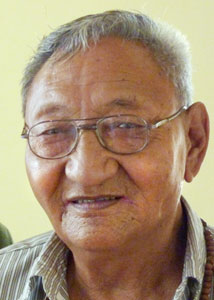Name: Jigme Paljor
(Alias: No)
Gender: Male
Interview Age: 69
Date of Birth: 1941
Birthplace: Jorgay, Utsang, Tibet
Year Left Tibet: 1959
Profession: N/A
Monk/Nun: No
Political Prisoner: No

Interview No.: 47M
Date: 2010-04-08
Language: Tibetan
Location: Doeguling Settlement, Mundgod, Karnataka, India
Categories: Culture and History
Keywords: childhood memories, Chinese -- first appearance of, Chinese rule -- life under, education, escape experiences, landowners, refugee in India -- life as, Utsang
Summary:
Jigme Paljor's village of Panam is located between Shigatse and Gyangtse in Utsang Province. At the age of 6 he joined Narongshar, which was the biggest school in Lhasa. He was among one of the lucky few who got the opportunity to go to school. He fondly talks about his school life and the overall education system of that time. Reading and writing were taught in school, but other subjects such as math required private tutors. He describes the kite flying festival that was popular with the children in Lhasa.
Jigme Paljor's father had been educated in a British school in Lhasa and served as District Administrator of Gyangtse. They also owned farmland in Shigatse. Jigme Paljor left school at age 16 and went to help on the family's farm. The Chinese entered the region and handed out coins and gifts, but Jigme Paljor's father was suspicious of their motives. Promoted as the Chief Minister of Lhoka in 1959, his father could not take charge of office on account of the fighting between the Chinese and Tibetan resistance.
Jigme Paljor's family escaped to India as soon as they heard about His Holiness the Dalai Lama's escape in 1959. They reached India after a 10-day journey along with thousands of other soldiers, monks, and government officials. Jigme Paljor was selected as one of the first batch of 50 students to study at a Tibetan school in Mussoorie. He then served as a teacher for 30 years.
Interview Team:
- Marcella Adamski (Interviewer)
- Tenzin Yangchen (Interpreter)
- Pema Tashi (Videographer)

